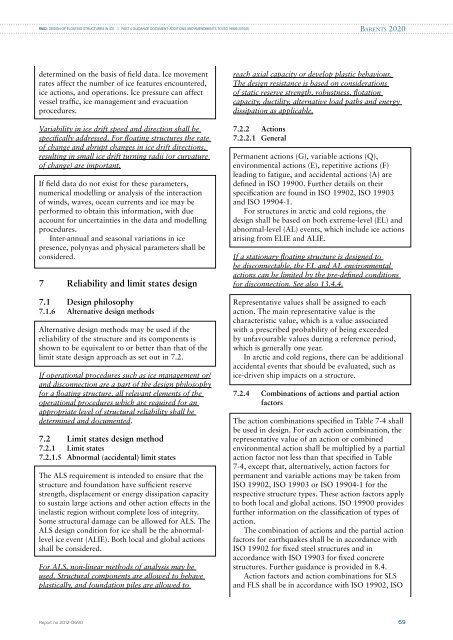phase 4 report - DNV
phase 4 report - DNV
phase 4 report - DNV
You also want an ePaper? Increase the reach of your titles
YUMPU automatically turns print PDFs into web optimized ePapers that Google loves.
RN02: DESIGN OF FLOATING STRUCTURES IN ICE // PART 4 Guidance Document: Additions and Amendments to ISO 19906:2010(E)Barents 2020determined on the basis of field data. Ice movementrates affect the number of ice features encountered,ice actions, and operations. Ice pressure can affectvessel traffic, ice management and evacuationprocedures.Variability in ice drift speed and direction shall bespecifically addressed. For floating structures the rateof change and abrupt changes in ice drift directions,resulting in small ice drift turning radii (or curvatureof change) are important.If field data do not exist for these parameters,numerical modelling or analysis of the interactionof winds, waves, ocean currents and ice may beperformed to obtain this information, with dueaccount for uncertainties in the data and modellingprocedures.Inter-annual and seasonal variations in icepresence, polynyas and physical parameters shall beconsidered.7 Reliability and limit states design7.1 Design philosophy7.1.6 Alternative design methodsAlternative design methods may be used if thereliability of the structure and its components isshown to be equivalent to or better than that of thelimit state design approach as set out in 7.2.If operational procedures such as ice management or/and disconnection are a part of the design philosophyfor a floating structure, all relevant elements of theoperational procedures which are required for anappropriate level of structural reliability shall bedetermined and documented.7.2 Limit states design method7.2.1 Limit states7.2.1.5 Abnormal (accidental) limit statesThe ALS requirement is intended to ensure that thestructure and foundation have sufficient reservestrength, displacement or energy dissipation capacityto sustain large actions and other action effects in theinelastic region without complete loss of integrity.Some structural damage can be allowed for ALS. TheALS design condition for ice shall be the abnormallevelice event (ALIE). Both local and global actionsshall be considered.For ALS, non-linear methods of analysis may beused. Structural components are allowed to behaveplastically, and foundation piles are allowed toreach axial capacity or develop plastic behaviour.The design resistance is based on considerationsof static reserve strength, robustness, flotationcapacity, ductility, alternative load paths and energydissipation as applicable.7.2.2 Actions7.2.2.1 GeneralPermanent actions (G), variable actions (Q),environmental actions (E), repetitive actions (F)leading to fatigue, and accidental actions (A) aredefined in ISO 19900. Further details on theirspecification are found in ISO 19902, ISO 19903and ISO 19904-1.For structures in arctic and cold regions, thedesign shall be based on both extreme-level (EL) andabnormal-level (AL) events, which include ice actionsarising from ELIE and ALIE.If a stationary floating structure is designed tobe disconnectable, the EL and AL environmentalactions can be limited by the pre-defined conditionsfor disconnection. See also 13.4.4.Representative values shall be assigned to eachaction. The main representative value is thecharacteristic value, which is a value associatedwith a prescribed probability of being exceededby unfavourable values during a reference period,which is generally one year.In arctic and cold regions, there can be additionalaccidental events that should be evaluated, such asice-driven ship impacts on a structure.7.2.4 Combinations of actions and partial actionfactorsThe action combinations specified in Table 7-4 shallbe used in design. For each action combination, therepresentative value of an action or combinedenvironmental action shall be multiplied by a partialaction factor not less than that specified in Table7-4, except that, alternatively, action factors forpermanent and variable actions may be taken fromISO 19902, ISO 19903 or ISO 19904-1 for therespective structure types. These action factors applyto both local and global actions. ISO 19900 providesfurther information on the classification of types ofaction.The combination of actions and the partial actionfactors for earthquakes shall be in accordance withISO 19902 for fixed steel structures and inaccordance with ISO 19903 for fixed concretestructures. Further guidance is provided in 8.4.Action factors and action combinations for SLSand FLS shall be in accordance with ISO 19902, ISOReport no 2012-0690 69






![Risk Based Pipeline Integrity Management [Compatibility Mode] - DNV](https://img.yumpu.com/50424229/1/190x146/risk-based-pipeline-integrity-management-compatibility-mode-dnv.jpg?quality=85)









